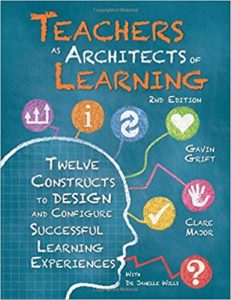12 Constructs to Design and Configure Learning
Teachers as Architects of Learning: Twelve Constructs to Design and Configure Successful Learning Experiences, Second Edition
By Gavin Grift and Clare Major
(Solution Tree, 2020 – Learn more)
Reviewed by Helene Alalouf
 Since my son is an architect, and my favorite desk was a drafting table for grading my middle schoolers’ assignments and lesson planning (as well as organizing my stamp collection) this title appealed to me.
Since my son is an architect, and my favorite desk was a drafting table for grading my middle schoolers’ assignments and lesson planning (as well as organizing my stamp collection) this title appealed to me.
I want to share how pleased I am with the instructional design framework Grift and Major present for educators, especially if you are in some way supporting teachers in developing and implementing evidence-based practices with the goal of improving learning for all your students.
Each of the authors’ 12 “constructs” is used both by the teacher to support learning processes and by the student during learning.
The Twelve Constructs
- Questioning to promote curiosity and inform learning
- Self-assessment for reflection and feedback
- Observing and listening, after modeling, to illuminate thinking
- Explicit instruction of understanding and processes, before students demonstrate and apply
- Modeling and exemplars, including demonstration, discussion, and analysis of both products and processes
- Support and safety for personal connections and academic risk-taking
- Time management that “relies on decisions made through planning, prioritizing, and maintaining focus” (p. 20)
- Expectations communicated as “the belief that with further effort the learner will improve and succeed” (p. 20)
- Lifeworlds of mindset, background knowledge, and connections
- Desire and motivation to learn, sparked by the teacher’s instructional design
- Assets that are “appropriate, effective, and powerful human and nonhuman resources to foster learning success” (p. 21)
- Existing knowledge as a filter for use and differentiation
Structure and Strategies

- a definition and research-based rationale of its importance;
- strategies for action;
- sample scenarios;
- descriptors of how learning is influenced when the construct is missing and when it is evident;
- a Think and Reflect set of questions and prompts for individual and collaborative awareness; and
- an annotated resource list titled “Supporting ideas and research.”
While most of the classroom scenarios are at the secondary school level to illustrate when the same lesson has the construct both absent and present, some of the specific strategies throughout the book offer applications at the elementary grade levels.
Another “glow” is the practical guidance. Informed by their lifetime experiences in teaching, administration, and psychology, the authors identify multiple strategies to support us in developing our capacity to support all learners.
For example, I was most impressed by the construct of Time. As an instructional coach who spends a lot of time planning and providing feedback, I am always seeking ways to be more efficient and effective, and appreciated the following strategies for time, which hinge on several of the other constructs (p.79-80):
► Prioritize high-leverage standards.
► Be flexibly responsive and authentically integrative within the learning experience by connecting concepts, knowledge, skills, and literacy.
► Review work on an ongoing basis to check for understanding and for students to process, duplicate, and replicate what they are learning. “Time for reflection is imperative to assess where students are with their learning and to provide them with the chance to learn from one another, but it is often overlooked during the construction of a lesson” (p.79).
► Find time for feedback with connecting, modeling, collaboration, reflection, and revision.
When I was pursuing National Board Certification in ELA Early Adolescence, I read the Carnegie report Turning Points, which identified the volatile disconnect between education and adolescents. This led to my realization that I had to make changes in my pedagogical approach to support learning.
The authors make a compelling case for the use of the constructs, not only with the research citations, but with a case study describing the experience of an eighth grader who was four years behind but gained two years growth in one year.
Reader’s Tips
May I suggest pausing your reading at certain points. For example,
► As I read the scenario accompanying each construct, I analyzed it to predict how the construct was absent or present before reading the authors’ analysis. Also consider what elements you should commit to memory, which the authors advocate as part of the learning.
► Select 1-2 of the Reflection questions and journal a takeaway, such as a rationale or a strategy, and an action you will take to apply this construct in your own planning and instructional delivery. After implementation, come back to jot any insights or changes you noticed.
Whether you are a reflective educator or school leader or education professor, you will find this text a warehouse of considerations of what is important when planning and teaching in order to optimize the learner’s journey. Best wishes on your new design for learning!
Since attaining her Masters from Teachers College, Columbia University, and later National Board Certification, education consultant Helene Alalouf has relished opportunities to share her passion and informed fluency of research-evident principles. Her goal is to help ensure a productive learning environment, cognitively and affectively, to support educators and families in realizing their vision. Learn more about her consulting here. At leisure, Helene enjoys walking and cooking with family and friends, reading, and knitting.



































